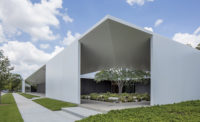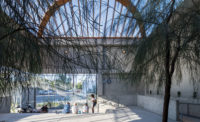When Chicago’s Museum of Contemporary Art (MCA), designed by German architect Josef Paul Kleihues in accord with his theory of “poetic rationalism,” opened in 1996, its 151,000 square-foot interior—distinguished by barrel vaulted galleries around an atrium—was well received. But critical reaction to its exterior—a five-story symmetrical composition clad in a relentless grid of cast aluminum and limestone panels—was decidedly negative. Blair Kamin, writing in the Chicago Tribune, dismissed it as “a cold, colorless culture palace.” Stanley Tigerman called it “an embarrassment.”
MCA’s unyielding geometry was the last gasp of neo-rationalism, a stripped down classical language that had flourished in the postmodern 70s and 80s. Just one year after MCA’s completion, the opening of Frank Gehry’s Guggenheim Museum in Bilbao heralded the hegemony of a very different style.
The mission of museums had also moved on. MCA was conceived in the tradition of cloistered containers for the contemplation of art. But before it was finished, the paradigm was shifting toward transparency, openness, social engagement, and community outreach. This is the direction in which director Madeleine Grynsztejn has chosen to lead MCA with a recently completed $16-million renovation, designed by Los Angeles-based Johnston Marklee (JM).
As artistic directors of this year’s Chicago Architecture Biennial, titled "Make New History," architects (and spouses) Sharon Johnston and Mark Lee were sympathetic to the Kleihues design’s hybrid historic form. “We looked at it with love,” recalls Lee. “Kleihues described it as somewhere between Schinkel’s Altes Museum and Mies’ New National Gallery, between the neoclassical and the modern. We asked, how can we help solve its problems through the lens of its original intentions?”
They focused on the problems of cramped circulation and inadequate non-gallery public space by reconfiguring the ground floor of the building’s northern flank, merging a lobby for an existing theater with a new restaurant to create the “Street,” an alternate path to and from the main floor above, as well as a social gathering place. Pedestrians looking into Kleihues’ big square gridded windows now see a lively and stylish dining room, bar and lounge instead of institutional classrooms.
A new elliptical stair leads up to the “Commons,” a multipurpose area that opens onto a terrace overlooking the museum’s garden. Above, JM inserted a third floor classroom and meeting area in what had been the upper half of a two-story café. Visible from the atrium, it “puts education front and center,” says Grynsztejn. The project has transformed 9,000 square feet and added 3,000 more with no changes to the exterior.
JM have made their interventions with linear precision and painterly warmth. Delicate white plaster vaults modulate the Street’s ceiling, recalling the barrel vaults of the upper level galleries and, according to Lee, “dialing back to the neoclassical.” Walls are sheathed in panels of birch stained a rich chestnut color, a finish repeated in the stair and in other millwork, mixing with richly veined black and white marble and brightly colored upholstery to strike a balance between cool and warm. British artist Chris Ofili has decorated the restaurant, called Marisol (after the artist who painted the first work acquired by MCA), with monochrome drawings and polychrome murals. Mexico City-based designers Pedro y Juana have covered the ceiling of the Commons, which will feature new installations by other artists every few years, with festive pendants.
Grynsztejn has fulfilled her commitment to community outreach by opening the Street to the public without paying admission. “We’re trying to make the ground floor part of the life of the city,” explains Johnston. “Kleihues intended his building to be a station on a journey from the city to the lake. It’s a beautiful metaphor, but it didn’t quite work out as he envisioned it.” Now, thanks to Johnston and Lee’s sure-handed redesign, visitors can follow a promenade that begins on Mies van der Rohe Way and ends in a garden with views toward Lake Michigan. What could be more rational or poetic?












Post a comment to this article
Report Abusive Comment